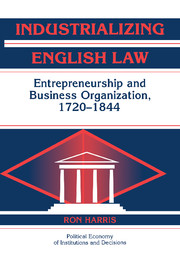Book contents
- Frontmatter
- Contents
- List of Tables
- Acknowledgements
- Introduction
- 1 The Legal Framework
- PART I BEFORE 1720
- PART II 1721–1810
- PART III 1800–1844
- 8 The Attitudes of the Business Community
- 9 The Joint-Stock Company in Court
- 10 The Joint-Stock Company in Parliament
- Conclusion
- Appendix 1 The Rise and Decline of the Major Trading Corporations
- Appendix 2: Capital of Joint-Stock Companies Circa 1810
- Bibliography
- Index of Cases
- Index of Statutes
- General Index
10 - The Joint-Stock Company in Parliament
Published online by Cambridge University Press: 12 August 2009
- Frontmatter
- Contents
- List of Tables
- Acknowledgements
- Introduction
- 1 The Legal Framework
- PART I BEFORE 1720
- PART II 1721–1810
- PART III 1800–1844
- 8 The Attitudes of the Business Community
- 9 The Joint-Stock Company in Court
- 10 The Joint-Stock Company in Parliament
- Conclusion
- Appendix 1 The Rise and Decline of the Major Trading Corporations
- Appendix 2: Capital of Joint-Stock Companies Circa 1810
- Bibliography
- Index of Cases
- Index of Statutes
- General Index
Summary
Having studied the attitude toward the joint-stock company in the business community and in the judiciary, we are now in a position to turn to an examination of the range of opinions in Parliament and in the government itself toward this form of business organization. While the company had become more popular with entrepreneurs and investors alike beginning in the late eighteenth century, it was not well received by the dominantly conservative judiciary, and the split between the economic reality and the legal framework reached a critical point. As a result, in 1824–1825, Parliament was forced to put the issue on its agenda for the first time since 1720, and to try to deal with the two conflicting outlooks.
The present chapter examines the debates in Parliament in 1824–1825 which led to the repeal of the Bubble Act. The Whig attempts at reform between 1830 and 1841 are studied next. The limited effectiveness of these attempts is examined in the context of the debate on the role of liberal ideology and the administrative competency of the Whig governments of this period. Finally, this chapter turns to Gladstone's Select Committee and the Joint-Stock Companies Act of 1844, which was based on the committee's recommendations. Gladstone's role in this reform is examined in the context of his early career. The act itself and accompanying legislation are analyzed in terms of laissez-faire and State intervention.
- Type
- Chapter
- Information
- Industrializing English LawEntrepreneurship and Business Organization, 1720–1844, pp. 250 - 286Publisher: Cambridge University PressPrint publication year: 2000



